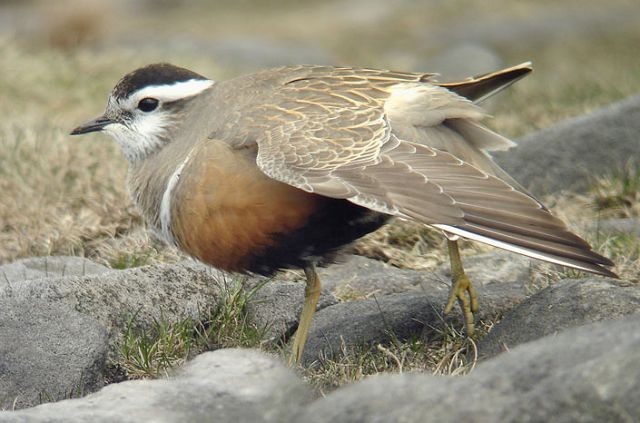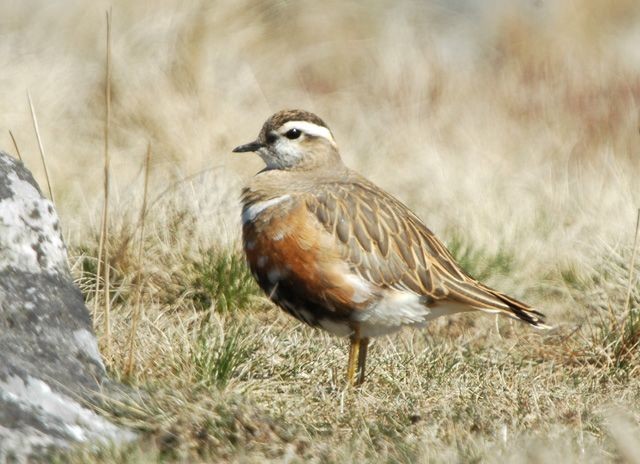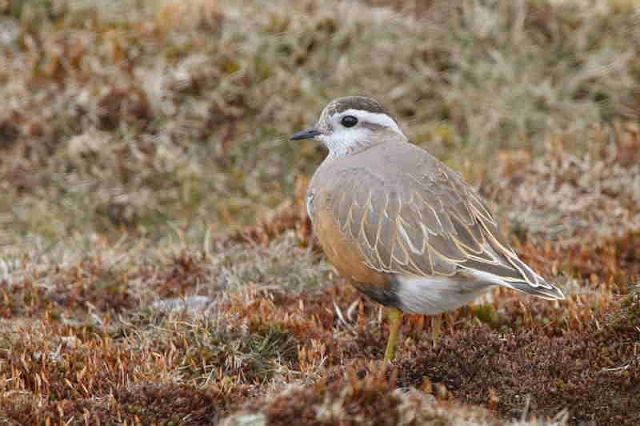
Dotterel (photo: Mark Breaks).
For many the Dotterel can lay claim to being the most beautiful wader to occur in Britain and Ireland. The attractive combination of a white supercilium and whitish breast band contrasting with the bright burnt-orange belly, particularly on the brighter female, make observing this wonderful wader a captivating experience. Given its scarcity and remote choice of habitat in Britain, this arctic-alpine wader is a most alluring species for all birders, and few can fail to be enthralled by this enchanting, and often confiding, plover.
The British population is estimated to be in the region of 840-950 pairs, nearly all of which are to be found in the Scottish Highlands. Although very small numbers now occasionally breed in the uplands of Northern England and Wales, in the mid-19th Century the English breeding population was estimated at 50-75 breeding pairs up to 1860 and they continued to breed annually until 1927. Climate change and recreational disturbance suggest that such numbers are unlikely to be regained in the near future. The remoteness of the breeding areas, frequently located above 700 metres in the central Highlands, ensures that relatively few birders see the species in its breeding habitat and most have to be content with encounters with passage birds, usually during the spring period.

Dotterel (photo: Kev Joynes).
Dotterels breed across the arctic tundra and arctic-alpine zone of Eurasia, with small numbers on the uplands of southern and central Europe; the European population is put at between 11,000 and 42,000 pairs. During the breeding season some pairs nesting in Scotland may travel further north and breed again in Norway. Wintering groups gather in the semi-arid belt from Morocco eastwards to Iran, with some wintering in Spain. For birds breeding in eastern Siberia this involves a journey of 10,000km. Birds begin leaving their wintering areas in late February and travel in small groups which stop at traditional staging posts on their way northwards to their breeding grounds. In Britain most 'trips' can be encountered from mid-April, the majority in late April and early May. The timing for encountering trips depends largely upon prevailing weather conditions.
Many of these traditional sites have been used for many years, with local avifaunas drawing attention to them through the generations. Such sites accommodated trips into the hundreds providing 'sport' for the hunters of the time. Dotterels are confiding birds, both on their breeding grounds and on passage, with inquisitive birds often approaching quite closely to the observer. A naturalist in 1791 commented that 'They are stupid birds easily enticed into a net'. Their confiding nature was their downfall during the 18th and 19th centuries when the breast feathers were prized by fisherman and they were eaten as food. To supply this trade the shooting of passage birds in spring was common practice and one commentator noted that 'The Dotterel visit our large open fields every spring and autumn, and dire is the slaughter committed amongst them'. Gamekeepers travelled some distance to engage in this 'sport' and one inn that accommodated the shooters at Reighton near Filey, North Yorkshire, was even named The Dotterel Inn as a lasting testament to this annual massacre involving many hundreds, if not thousands, of birds.
Although birds can be seen at a number of sites in the autumn, by far and away the best chance of seeing good numbers of birds and encountering them in their breeding finery is a visit to a known 'trip' location during the spring migration period. Often birds only remain for short periods of time before they move on, so responding quickly to the latest information is essential to increase your chances of success. Trip locations are often involve newly ploughed fields, or freshly sown pea fields, or inland moors where groups favour areas of burnt heather. Some sites are used from year to year, whilst others are used periodically making Dotterel unpredictable quarry to locate.
There are a number of favoured locations throughout the country, but please remember to keep disturbance of other birds at these sites to a minimum and respect rights of public access. Despite the fact that Dotterel are confiding, please watch the birds from a reasonable distance. These birds are using the area as a staging post and unnecessary disturbance causes them to use up valuable fat reserves. What follows is a list of some of the better-known sites, but there is always the possibility of finding your own birds in any area of suitable habitat during the spring migration period. Many sites can also hold small numbers of birds during the autumn too.

Dotterel (photo: Ian Fulton).
East Anglia
Cambridgeshire
The Fens: Explore the fen fields along the minor roads to the west of the A141 between Warboys and Chatteris especially around Blackbush, Honey and Honeypot Farms. Some of the farm tracks are private, so please respect this. Anywhere in the fens could be a potential area, with birds being seen on Farcet Fen, near Yaxley, last year too.
The Gog Magog Hills: A line of chalky hills running around the south of Cambridge. The best area seems to be in the triangle formed by the A10-A505-M11 around the villages of Foxton and Fowlmere. Birds have also been seen on the eastern side of the M11 near Fulbourn too.
Norfolk
There are no regular sites, but coastal fields around Weybourne, between Happisburgh and Eccles-on-Sea and between Winterton-on-Sea and Hemsby have attracted birds in the past. Blakeney Point also picks up a number of birds, but more often during the autumn.
Wales
Carmarthenshire
Garreg Lwyd: The area around the summit c. SN740179 has accommodated birds in recent years.
Mynydd Du: Formerly used, the cairns at Tair Carn Isaf and Tair Carn Uchaf SN6816 offered the best chance of success. Park by the crossroads SN668163 on the minor road north of Twynmynydd and walk northeast to the cairns.
Conwy
Great Orme: Small numbers regularly occur on the headland SH7583, favouring the short turf, but this area tends to be popular with tourists so ensure that you are there early before the birds get disturbed.
Southwest England
Cornwall, Devon and Isles of Scilly
Scarce birds in the region in spring, most tend to occur in the autumn. Favoured locations include the airfields at St. Just, Davidstow and on St. Mary's. Other sites include Castle Down, Tresco and Lundy.
Southeast England
Hertfordshire
Baldock: This area has been a regular stopover site for birds, but success depends upon the suitability of the fields. Favoured areas lie between Newnham and Ashwell TL2538, but in some years birds can be found between Baldock and Wallington, between Bygrave and Ashwell, or Guilden Morden.
East Sussex
There have been relatively few records in recent years, though a small parry was at Ditchling Beacon TQ3212 in spring 2006. In the past parties have been reported from Newmarket Hill TQ362070 and Gardener's Hill TQ4603.
Kent
St Margaret's at Cliffe TR345428: From year to year the field and their location varies, but is usually near the South Foreland Lighthouse (NT). This is accessible from the Reach Road lay-by, following the signposted public footpaths.
Elsewhere, birds have been seen on passage in the Thanet area where sightings have been in ploughed fields adjacent to the local Manston Airport. Birds have also been seen at Sandwich Bay.

Dotterel (photo: Johnny Carr).
Northeast England
East Yorkshire
Swinefleet SE7621: The pea fields in this area are a traditional stopping-off site. To reach the area head east along the A161 from Goole to Swinefleet. From the A161 to the east of Swinefleet explore the minor roads heading north to Reedness, Little Reedness and Whitgift, checking likely fields.
Aldbrough TA2438: Any suitable fields in the vicinity of the village are worthy of closer scrutiny and several 'trips' have frequented the area in recent years.
Lincolnshire
Deeping St. Nicholas TF2116: From the A16 through the village take any of the minor roads north or south, and explore the area looking for suitable pea fields, though there have been very few reports in recent years. Other areas in the county where trips have been seen include Marshchapel and Tetney Marshes.
Northumberland
Holy Island: This is perhaps the most reliable site in the county, but birds are still far from annual. When present, they favour fields by the Straight Lonnen NU127432, or on the drier dune slacks at NU126436.
North Yorkshire
Danby Beacon NZ736093: This site on the North Yorkshire Moors is frequently used by trips of Dotterel. From the A171 Guisborough to Whitby road, turn south just before the B1366 to Loftus at NZ719120 and follow the minor road south, turning east at NZ712108 and continue along the road to the viewpoint and car park NZ736093. View all 'burnt' vegetation for Dotterel.
Shunner Howe SE737996: Another site on the North Yorkshire Moors, used frequently in the 1980s when flocks of over 80 birds were sometimes seen. Head north from Rosedale Abbey along the minor road towards Egton Bridge. Once you reach the point where the Lyke Wake Walk crosses the road park at SE744994. Walk west for about half a mile and explore the areas of low vegetation around the summit SE733998.
Ingleborough SD741745: The summit area presumably turns up birds in most years, but it is not one of the easier upland sites to look for Dotterel with a strenuous uphill walk to reach the summit.
South Yorkshire
Burbage Moor: This area of moorland to the southwest of Sheffield has been quite reliable over the years. Park by Burbage Rocks SK262828 and walk across the moor in a southeasterly direction to explore cleared areas between there and Ox Stones. Alternatively park by Lady Canning's Plantation SK278834 and walk southwest across the moor looking at all areas of suitable habitat.
Axle Lane, South Anston: Small numbers are seen in most years in the Axle Lane area to the west of South Anston. The large fields in this area can be viewed from the busy A57 (please park carefully). A much better (and safer) option is to take the public footpath west from South Anston SK512837 towards Todwick and scan the fields.
West Yorkshire
Ilkley Moor: This site near Bradford has, over the years, been a regular stopover for Dotterels and the birds favour the short vegetation around the stone circle known as the Twelve Apostles SE126450. To reach this area park in the car park at Cow and Calf rocks and take the short, but steep, route to the top. Alternatively take the footpath by Dick Hudson's pub on the minor road between Menston and Bingley; this allows for a celebratory drink afterwards!
Northwest England
Lancashire
Pendle Hill SD796418: This is 6 miles to the east of Clitheroe. Take the minor road to the north of Barley and park by the track to Pendle House Farm SD814416; from the farm take the tracks to the summit and explore bare areas in the summit area.
Midlands
Nottinghamshire
Gringley Carr: From the A631 at the western edge of Gringley-on-the-Hill SK731906, take the minor road east for quarter of a mile and then head north and follow the road over the Chesterfield Canal and look for suitable fields to the east and west of the road SK7292.
Worcestershire
Bredon Hill SO9540: The best fields for Dotterel have, in the last decade, been the more eastern ones, such as those above Conderton and Aston Under Hill. Every year that these fields have been under spring-sown rape, Dotterels have turned up; the maximum was 20 in one trip in May 1999. This year the 'Banbury Stone' summit tower and Lalu Farm at SO964397 appear to be the best possible starting points. Park considerately in Kemerton or Overbury village and walk up.
Malvern Hills: North Hill and Table Hill at north end of the Malverns have accommodated birds in recent years.
Scotland
Aberdeenshire
Less reliable than upland sites, but in the last five years fairly large trips (up to 30 birds) have been seen near RSPB Loch of Strathbeg and just south of St. Combs in the Corsekelly Farm/Tufted Duck hotel area.
Ayrshire
Blackcraig Hill: Fairly regular in recent years, the area around the trig point NS647066 is favoured.
Clyde
Green Lowther: Look for birds around the summit NS901120.
Lothian
Carnethy Hill: Again the summit area NT204619 represents a good chance of connecting with small numbers of birds.
Remember, numbers vary from year to year and birds often tend to be mobile and move through quite quickly, so success is less than guaranteed. In some years some of the sites mentioned above do not attract any birds, so it is essential to use the search facility on Bird News Extra for all the latest details.
References
Finding Birds
in Britain. Lee G R Evans, BirdGuides
Ltd 2001.
Brown and Grice. 2005. Birds in England. Poyser, London.
Birdlife International. 2004. Birds in Europe: Population estimates, trends and conservation status. Cambridge, UK: Birdlife International. (Birdlife Conservation Series No. 12).
Acknowledgements
Thanks to Angus Murray, Mashuq Ahmad, Jono Leadley, Steve Whitehouse, and Andy Hirst.
This is an updated version of an article that first appeared on Bird News Extra in 2002.


